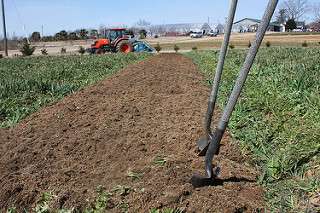Though ploughing has long been associated with water loss and topsoil destruction, Dr Renton says occasional mouldboard ploughing can be used to bury herbicide-resistant weed seeds, effectively removing them from the gene pool. Credit: UGA College of Ag & Environmental Sciences - OCCS
Tossing topsoil around in Australia's often arid farming environment is not best practice, but modelling suggests an occasional turning of the soil can delay the rise of herbicide-resistant weeds.
A key weapon in the fight, says UWA's Dr Michael Renton, is the strategic use of occasional mouldboard ploughing—the equivalent of "going in with a shovel, digging up the soil, turning it over, then putting it back down."
"Whatever was on top of the soil gets buried deep, and whatever was deep gets brought to the surface," he says.
Though ploughing has long been associated with water loss and topsoil destruction, Dr Renton says occasional mouldboard ploughing can be used to bury herbicide-resistant weed seeds, effectively removing them from the gene pool.
"Efficacy is really important…if you're going to do it, you need to be sure you're really burying the seed," he says.
Fast-forward forty years…
As part of his research Dr Renton ran hundreds of computer simulations to predict the effect of mouldboard ploughing on herbicide-resistant annual ryegrass, modelling 40 years of cropping in just a few minutes.
Each simulation covered a different combination of farm management and tillage practices, genetic scenarios for the spread of herbicide resistance, and efficiency and regularity of mouldboard ploughing.
Originally designed to examine the genetics of herbicide resistance and the effect of low herbicide doses, the model—named Polygenic Evolution of Resistance To Herbicides, or PERTH—needed modifications for the study.
"The original PERTH assumed the seed was all at one depth in the soil," Dr Renton says.
"We needed to extend the model, so you could model different layers of soil, to show where the seed was buried."
Dr Renton also adapted the model to represent the use of residual herbicides, which remain in the soil, killing weeds as they germinate.
The results clearly indicated an annual onceover with the mouldboard plough was most effective at reducing weed problems.
However, with more than 90 per cent of WA's farmers reaping the benefits of no-till farming, Dr Renton is quick to qualify the result.
"Annual mouldboard ploughing is the best way to control weeds, however, you don't want to do it every year, because you'll get all these other environmental problems, and it's also expensive and takes lots of time."
The simulations indicated mouldboard ploughing every four years was a good option for weed control.
"Even once every eight years still had some benefits," Dr Renton says.
Provided by Science Network WA




















